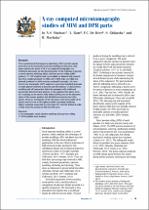JavaScript is disabled for your browser. Some features of this site may not work without it.
- ResearchSpace
- →
- Research Publications/Outputs
- →
- Journal Articles
- →
- View Item
| dc.contributor.author |
Muchavi, Noluntu S

|
|
| dc.contributor.author |
Bam, L

|
|
| dc.contributor.author |
De Beer, FC

|
|
| dc.contributor.author |
Chikosha, Silethelwe

|
|
| dc.contributor.author |
Machaka, Ronald

|
|
| dc.date.accessioned | 2017-08-22T13:07:39Z | |
| dc.date.available | 2017-08-22T13:07:39Z | |
| dc.date.issued | 2016-10 | |
| dc.identifier.citation | Muchavi, N.S., Bam, L., De Beer, F.C. et al. 2016. X-ray computed microtomography studies of MIM and DPR parts. Journal of the Southern African Institute of Mining and Metallurgy, vol. 116(10): 973-980. doi.org/10.17159/2411-9717/2016/v116n10a13 | en_US |
| dc.identifier.issn | 2225-6253 | |
| dc.identifier.uri | doi.org/10.17159/2411-9717/2016/v116n10a13. | |
| dc.identifier.uri | http://www.saimm.co.za/Journal/v116n10p973.pdf | |
| dc.identifier.uri | http://www.scielo.org.za/scielo.php?script=sci_abstract&pid=S0038-223X2016001000015 | |
| dc.identifier.uri | http://hdl.handle.net/10204/9448 | |
| dc.description | Journal of the Southern African Institute of Mining and Metallurgy, vol. 116(10): doi.org/10.17159/2411-9717/2016/v116n10a13 | en_US |
| dc.description.abstract | Parts manufactured through power metallurgy (PM) typically contain pores that can be detrimental to the final mechanical properties. This paper explores the merits of 3D X-ray computed tomography over traditional microscopy for the characterization of the evolution of porosity in metal injection moulding (MIM) and direct powder rolling (DPR) products. 17-4 PH stainless steel (as-moulded, as-debound and sintered) dog-bone samples produced via MIM and Ti-HDH strips (as-rolled and sintered) produced via DPR and were analysed for porosity. 3D micro-focus X-ray tomography (XCT) analysis on specimens from both processes revealed spatial variations in densities and the existence of characteristic moulding and roll compaction defects in agreement with traditional microscopic microstructural analysis. It was concluded that micro-focus XCT scanning can be used to study MIM and DPR parts for the characterization of the amount, position and distribution of porosity and other defects. However, the majority of the sub-micron sized pores could not be clearly resolved even at the highest possible instrument resolution. Higher-resolution scans such as nano-focus XCT could be utilized in order to fully study the porosity in MIM and DPR parts. | en_US |
| dc.language.iso | en | en_US |
| dc.publisher | The Southern African Institute of Mining and Metallurgy | en_US |
| dc.relation.ispartofseries | Worklist;19267 | |
| dc.relation.ispartofseries | Worklist;17996 | |
| dc.subject | X-ray tomography | en_US |
| dc.subject | Metal injection moulding | en_US |
| dc.subject | Direct powder rolling | en_US |
| dc.subject | 17-4 PH stainless steel | en_US |
| dc.subject | Titanium | en_US |
| dc.title | X-ray computed microtomography studies of MIM and DPR parts | en_US |
| dc.type | Article | en_US |
| dc.identifier.apacitation | Muchavi, N. S., Bam, L., De Beer, F., Chikosha, S., & Machaka, R. (2016). X-ray computed microtomography studies of MIM and DPR parts. http://hdl.handle.net/10204/9448 | en_ZA |
| dc.identifier.chicagocitation | Muchavi, Noluntu S, L Bam, FC De Beer, Silethelwe Chikosha, and Ronald Machaka "X-ray computed microtomography studies of MIM and DPR parts." (2016) http://hdl.handle.net/10204/9448 | en_ZA |
| dc.identifier.vancouvercitation | Muchavi NS, Bam L, De Beer F, Chikosha S, Machaka R. X-ray computed microtomography studies of MIM and DPR parts. 2016; http://hdl.handle.net/10204/9448. | en_ZA |
| dc.identifier.ris | TY - Article AU - Muchavi, Noluntu S AU - Bam, L AU - De Beer, FC AU - Chikosha, Silethelwe AU - Machaka, Ronald AB - Parts manufactured through power metallurgy (PM) typically contain pores that can be detrimental to the final mechanical properties. This paper explores the merits of 3D X-ray computed tomography over traditional microscopy for the characterization of the evolution of porosity in metal injection moulding (MIM) and direct powder rolling (DPR) products. 17-4 PH stainless steel (as-moulded, as-debound and sintered) dog-bone samples produced via MIM and Ti-HDH strips (as-rolled and sintered) produced via DPR and were analysed for porosity. 3D micro-focus X-ray tomography (XCT) analysis on specimens from both processes revealed spatial variations in densities and the existence of characteristic moulding and roll compaction defects in agreement with traditional microscopic microstructural analysis. It was concluded that micro-focus XCT scanning can be used to study MIM and DPR parts for the characterization of the amount, position and distribution of porosity and other defects. However, the majority of the sub-micron sized pores could not be clearly resolved even at the highest possible instrument resolution. Higher-resolution scans such as nano-focus XCT could be utilized in order to fully study the porosity in MIM and DPR parts. DA - 2016-10 DB - ResearchSpace DP - CSIR KW - X-ray tomography KW - Metal injection moulding KW - Direct powder rolling KW - 17-4 PH stainless steel KW - Titanium LK - https://researchspace.csir.co.za PY - 2016 SM - 2225-6253 T1 - X-ray computed microtomography studies of MIM and DPR parts TI - X-ray computed microtomography studies of MIM and DPR parts UR - http://hdl.handle.net/10204/9448 ER - | en_ZA |






